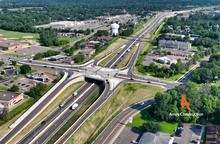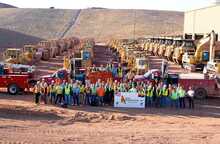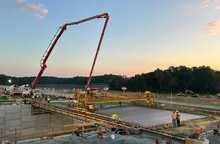Santa Anita Post-Fire Emergency Restoration Project
A two-year sediment removal project at the Santa Anita Reservoir in Southern California has increased critical water storage capacity.
After excavating nearly 500,000 cubic yards of sediment, Ames Construction crews are continuing to perform drainage work at the sediment placement site.
The emergency project was triggered by the 2020 Bobcat Fire in Los Angeles County. With a lack of vegetation in the watershed after the fire, heavy rains carried debris into the reservoir, reducing its capacity.
From the beginning, Ames worked in close partnership with LA County’s Santa Anita project management team. The county showed its confidence in Ames in the second season by reducing its project inspection staff by half.
“As congested as this jobsite is, the team communicated well and got everything done safely and effectively,” says Ames Senior Project Manager Tony Spinetti. “It was a great example of the team culture we have at Ames.”
Birds and bear and deer, oh my!
The San Gabriel Mountain Range is home to mule deer, mountain lions, black bear, big horn sheep, California condors, and may other species, some of which are endangered or threatened. The Ames crews on the Santa Anita project worked in harmony with all of them.
The project installed a conveyor belt to move sediment from the reservoir to the placement site. The day before the conveyor belt was to be tested for the 2024 season, the project’s on-site biologist discovered a mourning dove nesting in one of the belts. The nesting period would have put the project 30 days behind schedule. To avoid delay, Ames quickly devised a new alignment to bypass the belt, and LA County expedited authorization of the bypass. Ames implemented the change within three days, losing only two days of production.
A female black bear claims the site as part of her home. To protect her, Ames crews were trained in bear safety. The on-site biologist monitored activity, and crews kept the worksite exceptionally clean to avoid attracting bears with food waste. The project minimized impact to the trees, water sources, and natural pathways that bears rely on.
Deer posed another challenge. The contract required wildlife exclusionary fencing on both sides of the conveyor belt alignment to keep animals away from the work area. The deer, however, didn’t get the hint. In the first season, team members observed that the fencing seemed to confuse the deer and cause more problems than it solved. Collaborating with the biologist, Ames removed the fencing in the second season and implemented a 5-mile-per-hour speed limit. The plan was a success, giving wildlife a safer path through the project.
Above all, Ames crews left wildlife alone and gave them the right-of-way.
























